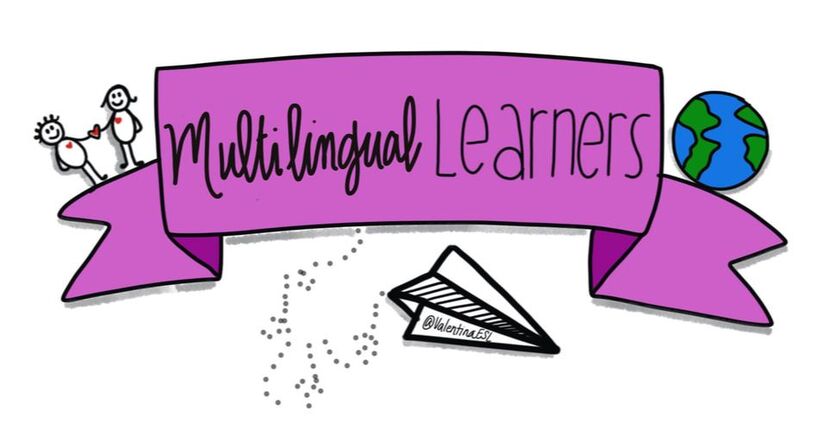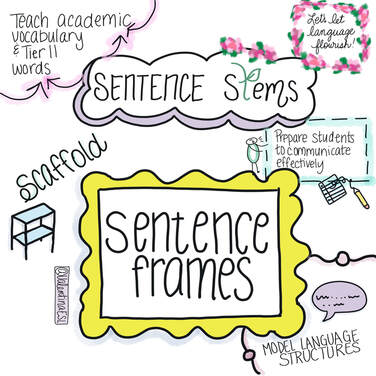What is the difference and Why should we care?Well, first and foremost, we should care if we want our students to speak like scholars. If we want our students to be marketable after they graduate. If we want them TO graduate! Then we should care! Sentence stems and frames are scaffolds as students learn language and content. Sometimes educators use the terms sentence stems, sentence starters and sentence frames interchangeably. You may wonder...are they the same thing? The answer is no, they are are not the same. They have their own form and function. Sentence Frames
Sentence frames essentially frame a sentence and students add in some verbiage. Think of a picture frame where you add in a picture. Sentence frames look very much like traditional fill in the blank sentences. Here are some examples of sentence frames:
Sentence frames are scaffolds that may fit the needs of English learners at beginning levels of English proficiency. Some students may also benefit from visuals and word banks. However, sentence frames can be used with English learners at higher levels of English proficiency to teach specific language structures or to teach mortar words/tier II words. Sentence Stems A sentence stem is the beginning of a sentence. Think of the stem of a plant. It's not the whole plant, just the beginning of it. It helps students get their sentence started. Sometimes we use the term sentence starter interchangeably. Sentence stems give students the inertia to get their thoughts going. Then their sentences bloom. Here are examples of sentence stems:
Sentence stems are scaffolds for English learners at all levels of English proficiency. They are open ended. Personalizing By thinking of the end in mind, you can level and personalize sentence frames or sentence stems to help English learners progress in language proficiency. Beginning-Simple sentence structure: ____and ___ are quadrilaterals. Intermediate-Comparative sentence structure: ___and ___ are quadrilaterals, however ___has___. Advanced-Complex comparative sentence structure: Although___and ___ are ___, ___is different because... Why is it important for us to provide students with sentence frames or sentence stems? Learning to communicate effectively is important for all of us. I think we can all agree on that. But providing students with vocabulary lists will not achieve that goal. Backward Design Let's begin with the end in mind again. What is our over-aching goal? If we want students to, let's say, understand and communicate effectively using domain specific vocabulary (vocabulary of our content area), then how will we get them there?
This model takes students through the Gradual Release of Responsibility or I do, We do, You do model. How do I think of vocabulary? Start with your grade level standard. Look at what students need to know. Whether it's Common Core or not, your state standards will reveal vocabulary that is critical for your students to master.
25 Comments
Trish
5/22/2019 06:12:12 pm
Thank you!!!
Reply
Linda Lamar
7/26/2021 02:10:24 pm
I would use the Frayer Voc. graphic organizer to introduce vocabulary.
Reply
Teresa Cotton
4/15/2019 09:08:20 pm
Just what I need to present during collaboration! Thank you!
Reply
VALENTINA GONZALEZ
5/22/2019 06:26:57 pm
Super! Thanks for reading and sharing!
Reply
Heather Gardner
4/20/2019 05:57:47 pm
Thank you so much for posting the difference AND importance between Sentence stems and Sentence starters. Many teachers on my team either will not use stems or starters, or use starters for students who are nearly proficient. We need to learn the difference and appropriately scaffold for our learners.
Reply
Maria Martinez
10/17/2019 09:42:21 am
Great information to take back and use with our students. In using sentence stems, sentence frames, and prepare students to communicate effectively.
Reply
Monica Gonzalez
7/3/2020 05:01:09 pm
I am an instructional coach and always looking for ideas for middle school and high school newcomers.
Reply
Anju Kharbanda
7/8/2020 01:50:53 pm
Thanks for the informational article. I think it's especially helpful to understand the difference between sentence stems and frames. Sentence stems are more beneficial because they can be open-ended and student to express their own thinking.
Reply
Kathy Andrews
8/17/2020 02:45:11 pm
Thank you for the response and resources
Reply
Lois Gallegos
12/3/2020 10:53:26 am
Modeling structure is very important because not all languages use the same structure. Let them know the order of their words is valid, in their 1st language, in English we put thing in different order. We're not wrong, we're just different.
Reply
Waymalida Delgadillo
12/6/2020 06:58:53 pm
Sentence framing is crucial for any language. The way a sentence is framed relays the thoughts and feelings of a person. It is important to understand the sentence structured in English is different than Spanish or any other language but all sentences relays thoughts and we have to teach our students how to structure them correctly so that it relays the message.
Reply
Amir Iqbal Sheikh
4/18/2021 04:07:51 pm
Using this cool stuff for my presentation tomorrow. Thanks
Reply
Nadia
5/28/2021 02:53:34 pm
I love backwards design! I have never really used sentence stems, but they way you presented was excellent!
Reply
Vimls Bhathena
6/2/2021 05:29:10 pm
Thanks for the amazing ideas to enhace the students communication skills.
Reply
Renuka Sangwan
6/2/2021 09:05:44 pm
This is a great article and like how it clearly states the difference and we need to use Both the strategies from time to time, to help our students get involved in academic discussions with the right use of vocabulary. We can start with sentence frames and when see our student's progressing, can move to sentence starters.
Reply
6/16/2021 02:04:04 am
Your posts are awesome. I found this much informative. Thanks for sharing these type of quality content. I appreciate your effort.
Reply
Audrey Reginald Mathias
6/16/2021 08:21:44 pm
This blog is a great start to start with Els Communicating Skills.
Reply
Linda Lamar
7/26/2021 02:22:55 pm
Great strategies! I believe in modeling the language we want students to use.
Reply
Christina
8/9/2021 01:15:01 pm
Great sentence stems! Will be using for my ELLs this year
Reply
patricia rushing
3/30/2022 02:18:29 pm
Thank you for explaining difference between sentence stem and sentence frame. I agree that our students need to hear words used in context and modeled from both teacher and peers and given the opportunity to use them in both speaking and writing. I like the suggestion of using the frayer model.
Reply
David Farley
4/12/2022 01:48:41 pm
I love how this was broken down for the EL learners and the educators. This approach will help me in all aspects of teaching not just for EL.
Reply
Kathleen Proudfoot
5/4/2022 01:24:43 am
I completely agree. i think the sentence stems help to getthe brain thinking .
Reply
Angela Taylor
5/2/2022 05:11:11 pm
Nice explanation of the difference between frames and stems.
Reply
Tonja Hamel
6/14/2022 04:30:27 pm
Great comparison of the sentence frame as a scaffold!
Reply
Your comment will be posted after it is approved.
Leave a Reply. |
Categories
All
|


 RSS Feed
RSS Feed
